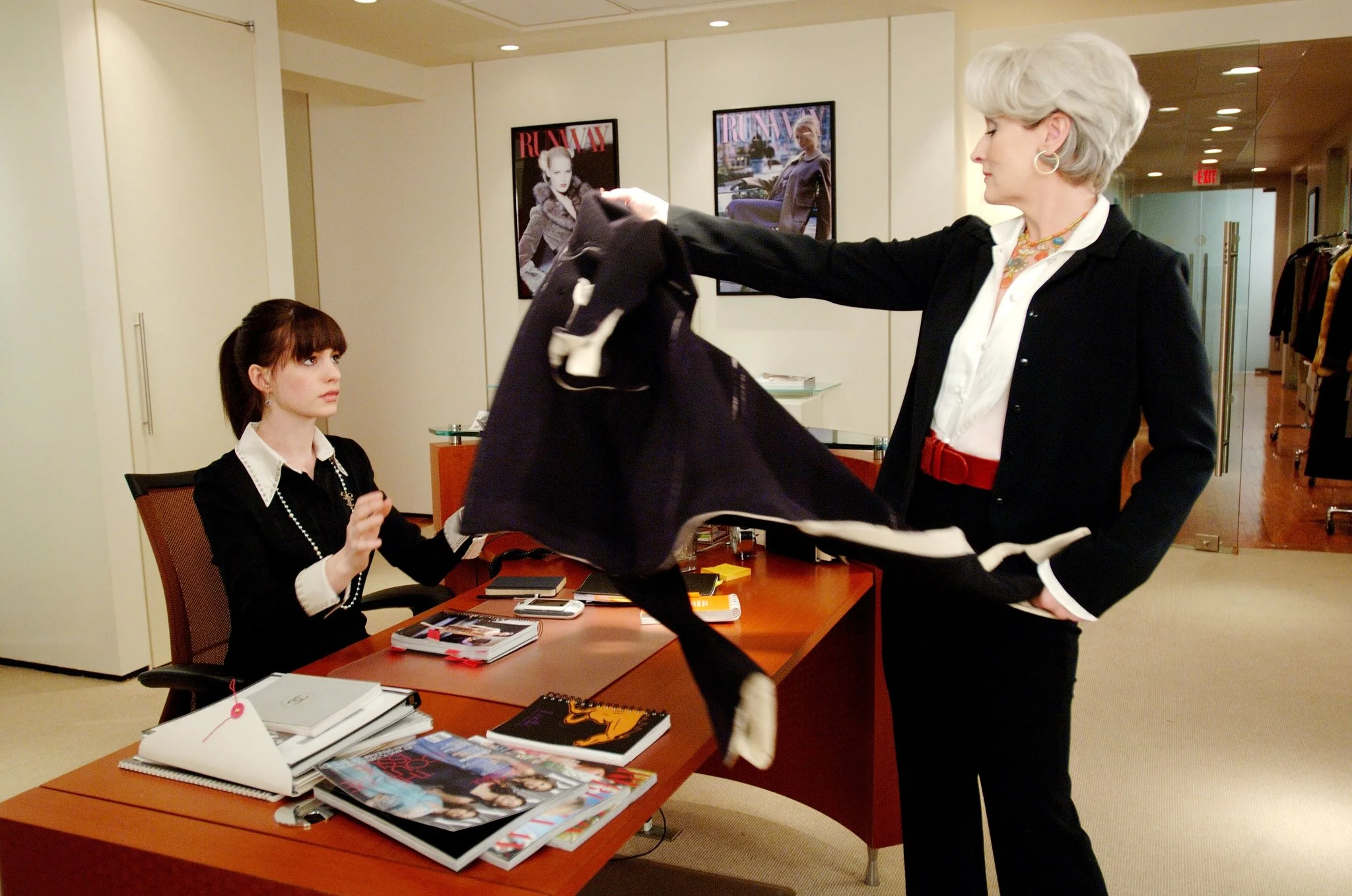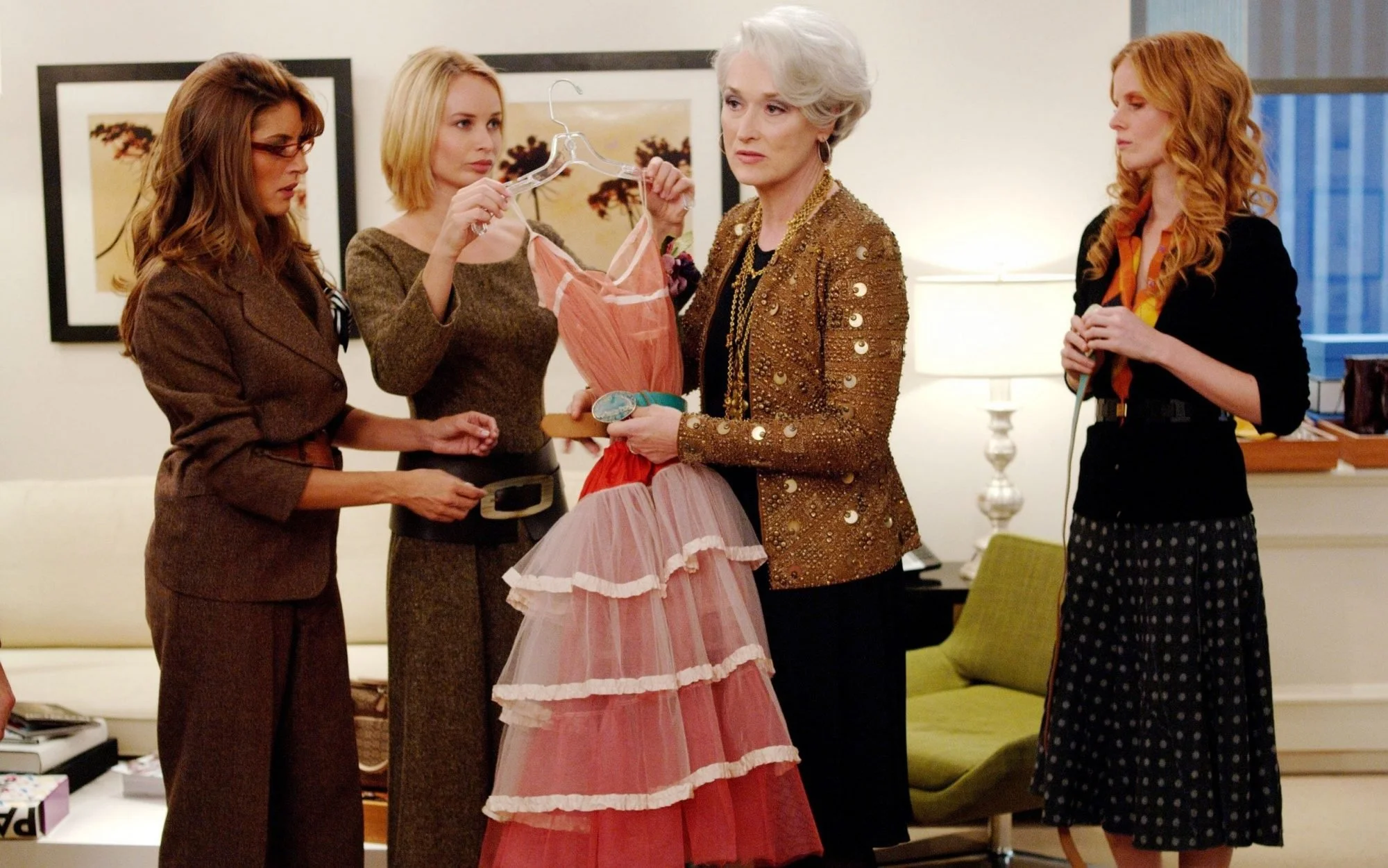Reframing the Devil that wears Prada
Guest Writer Liaw Xin Ru revisits the cult classic, The Devil Wears Prada (2006).
There are generally a few common responses as to who the “devil” spoken of in the title is. Most instinctively we point at the Prada-donning, Anna Wintour inspired “Ice Woman” Miranda Priestly. Or to others it is the slowly and surely metamorphosing Andy that brinks on surrendering everything and everyone amidst her chase to become more. And in more recent opinion, the jealous boyfriend who ties her down and can never seem happy for her successes. However, in my opinion, the devil never assumes human form.
It would not make much sense for Andrea to be the devil given her redemption at the end. Rather it seems as though she had broken out of a trance towards the end of the movie. And I posit that neither is the devil Miranda Priestly, as there are specific scenes set aside to humanise Queen Miranda, like when we enter and impose on her private space. It reminds us that even though devilish, Miranda is very much human too; victim to her own devils too. She finds herself at a distance with her (ex-)husband due to her dedication to work and even when she betrays Nigel’s loyalty, she does it for the sake of her work. She is never truly self-serving, but subservient to external forces which seem to be an intangible bigger entity. And lastly, I wouldn’t even spare a thought to Nate Cooper (I had to google “Andrea boyfriend”). He merely exists to ground Andrea’s character and only does so perpendicularly to Andrea, which is a rather refreshing change on mainstream media’s mass manufacturing of female characters to ground predominantly male protagonists. Sure he gets under our nerves, but he does not have the power or intent (or style…) to be the devil that wears Prada. Now that we have debunked the three main suspects, who is the devil? I propose it is more productive to ask Where is the devil? Think of the title as: If the devil were human, it would be wearing Prada (high fashion)— as an allegory to the toxicity of the fashion industry.
“Fashion” is an intangible concept. It is an industry, a zeitgeist, and most centrally an identifier, that allows the term “high fashion” to come into play. Andrea’s shifting appearance doesn’t merely reflect her deeper understanding of the world of fashion, but as a socio-economic status symbol where she climbs the corporate ladder(think of fashion as a corporation) and as she sheds her clearance bin outfit and dons Chanel boots, she is slowly but surely climbing up the social ladder too. This is also reflected, of course, by the costume designs. Andrea graduates from slouchy, lumpy silhouettes for straighter, harsher shapes as the movie progresses. The awkward, blu–cerulean, chunky sweater gradually becomes thinner fabrics layered, eventually becoming coats and playful collars. Sinisterism is visualised by such sharpness, as the device “Devil” conjures images of sharp horns, maybe clawed feet. Such symbols are encapsulated in the movie’s iconic poster featuring red, glossy heels with the devil’s trident at its tip. In this vein, high heels become the all-encompassing motif of this story. It is the most frequently occurring fashion item. Andrea’s first encounter with high fashion and transformation starts at the heels offered to her by Nigel, after she is condemned by Miranda, and this transformation comes full circle at the iconic “Chanel boots” scene. Even Miranda’s character is visually produced to us from her Prada heels, high and clacking demandingly upon the floor. The subsequent scene contrasts with the clatter of heels from employees scurrying to receive her presence. From this alone we see authority and subservience portrayed through heels. The nature of heels themselves serve as a perfect tool for this message– a body distorting sex symbol of domination and subordination that remains a timeless staple in women’s fashion.
Besides its visual intentions, I also aim to unpack the moral dilemmas of this piece, specifically how they are presented under the facade of superficiality. And when I say “facade of superficiality” I intend to illustrate the layers that the film tackles with regard to an appearance-driven world of fashion, which beneath it indeed harbours significance beyond mere aesthetics and as a result, breeds self-importance and sinisterism— setting it apart from other visually appetising movies by providing multitudes for the viewer; from icons to intention.
The devil lives vicariously through all who worship high fashion, whoever wears Prada. It is an omnipresent entity that possesses and pollutes, as observed in the key characters throughout the movie. Most obviously seen through Emily who physically sacrifices herself in the name of fashion, almost like a literal offering to the devil, as seen in the scenes where she toils away even in sickness, and starving herself to fit into her ballgown. Or Nigel, who was placed upon a pedestal only to fall from great heights, success relegated to a mere mirage he toiled for. Even Miranda suffers from her self-isolation in the name of fashion. Finally for our main character Andrea, conflict arises at points where fashion comes into play– eg. when she scoffs at the teal blue belts, when she dresses differently from her colleagues, and ultimately when she becomes an active consumer of high fashion. It provides a temporary sense of satisfaction and reconciliation(as seen in her colleagues’, or even her boss’, approval and inclusion.) yet corrupts and consumes in the long term, as seen in the deteriorating relationships between her and her loved ones, much like our very own obsessive consumption of luxury in daily life that provides peripheral gratification, leaving us in a perpetual state of wanting more and ultimately, in the most extreme circumstances, decay. In this sense, it is extendable to the Singaporean Dream and how the rat race corrupts and consumes us through our very own consumerism.
Singapore’s culture and peoples are plagued with similar dilemmas. Should Andrea attend the ball instead of her lover’s celebration? Echoes our shaky balance between work and life: Should I earn that OT or go home to my family? Growing up, we navigate the constant chase for more, the way we tumble through school and can barely catch a breather between being catapulted into the workforce and starting a family. Any gap between these predestined chapters of life seems to warrant concern from our family and society in general. Much like how Andrea’s life picks up accelerating pace upon working at Runway. Let me then extend this even further to the broader scheme of the world– the mass global consumption of today. The neoliberal restructuring that characterised the leap from the 1990s to the new age postulates that less regulation in the economy would grant the people more freedom, and thereafter, happiness. This can be said to be metaphorized as Andrea’s perilous exploration of a new free world unravelling infront of her, that seems to spiral out of control until she jams the breaks. If we allow it to, her character dilemma makes a parody out of us as inevitable mass consumers in a globalised world. And that is what a well matured film should do– allow us to face undesirable parts of ourselves. Further compounding my emphasis on our audience identity, this confrontation falls disproportionately heavy upon us as metropolitans. My first encounter with this movie was on a flight departing from the luxurious Changi Airport, where I’d witnessed the very same name brands that played on the screen before me just moments before. In power cities like Singapore, this New Yorker tale becomes relevant as a cultural critique that acknowledges the allure of excess consumption.
So, the idea is not who the devil is, but what the devil manifests as. As a social consciousness. Though she realises she “doesn’t want to live the way you(Miranda) live,” and puts the excitingly dangerous lifestyle behind her, Andrea remains a fashionable woman at the end of the movie. She can never turn back to the wide-eyed girl she was before. The lesson learnt is being able to balance our passions/drive, while ensuring that that very thing we have committed to falling in love with; does not nefariously consume us. And in the wider scheme of things, appreciate our metropolitan privileges while not letting ourselves get caught up in it. As a viewer, it is easy to spur Andrea on to make the right decision and free herself from the shackles of her suffocating job, yet the glamour of her lifestyle makes this decision so contentious. But how about us? Are we able to be brave like Andy and make the “right decision” for ourselves in a workaholic world? Indeed, they are “big shoes to fill”.



